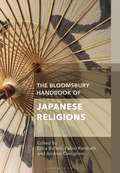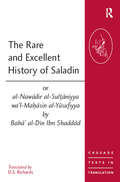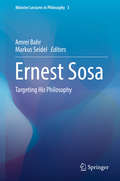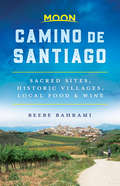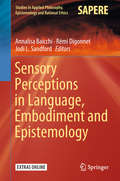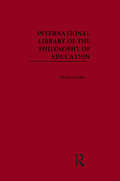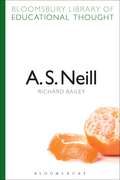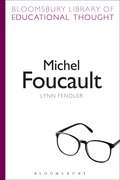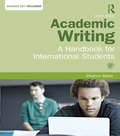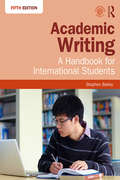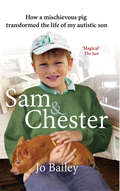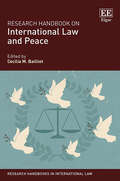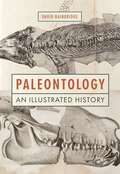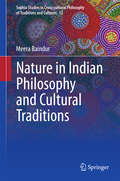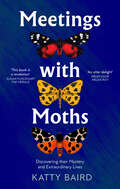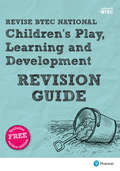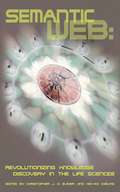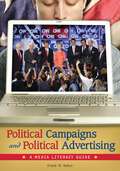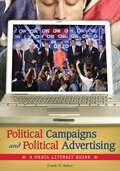- Table View
- List View
Responsible History (n/a)
by Antoon De Baets“I can warmly recommend Responsible History to any concerned historian in need of a reliable compass for responsible conduct. I endorse Voltaire’s words quoted in this book: ‘Those who can make you believe absurdities, can make you commit atrocities.’ Responsible conduct is necessary because irresponsible conduct is dangerous.” [From the Foreword.] The abuse of history is common and quite possibly once more on the rise. Although this is well documented, there is no general theory that enables historians to identify, prove, explain, and evaluate the many types of abuse of history. In this book, the author, founder of the Network of Concerned Historians, presents such a theory. Reflecting on the responsible use of history, the author identifies the duties that the living has toward the dead and analyzes the rights to memory and history necessary to fulfill these duties. He concludes his powerful argument by proposing a code of ethics as a guide for responsible historians. This work is vital for any historian who wants to oppose and prevent the abuse of history.
The Bloomsbury Handbook of Japanese Religions (Bloomsbury Handbooks)
by Erica Baffelli Andrea Castiglioni Fabio RambelliProviding an overview of current cutting-edge research in the field of Japanese religions, this Handbook is the most up-to-date guide to contemporary scholarship in the field. As well as charting innovative research taking place, this book also points to new directions for future research, covering both the modern and pre-modern periods. Edited by Erica Baffelli, Andrea Castiglioni, and Fabio Rambelli, The Bloomsbury Handbook of Japanese Religions includes essays by international scholars from the USA, Europe, Japan, and New Zealand. Topics and themes include gender, politics, the arts, economy, media, globalization, and colonialism.The Bloomsbury Handbook of Japanese Religions is an essential reference point for upper-level students and scholars of Japanese religions as well as Japanese Studies more broadly.
The Rare and Excellent History of Saladin or al-Nawadir al-Sultaniyya wa'l-Mahasin al-Yusufiyya by Baha' al-Din Ibn Shaddad (Crusade Texts in Translation)
by Bahā’ al-Dīn Ibn ShaddādSaladin is perhaps the one and only Muslim ruler who emerges with any clarity in standard tales and histories of the Crusades; this is a translation of Baha’ al-Din Ibn Shaddad’s account of his life and career. Ibn Shaddad (1144-1234) was clearly a great admirer of Saladin and was a close associate of his, serving as his qadi al-’askar (judge of the army), from 1188 until Saladin’s death in 1193. His position and his access to information make this an authoritative and essential source for Saladin’s career, while his personal relationship with the sultan adds a sympathetic and moving element to the account of his final years. Aside from its inherent value as a source for the history of Egypt and the Middle East, it therefore provides a much-needed complement and corrective to the widely-known Latin accounts of the Crusades and the Latin Kingdom of Jerusalem in the 12th century. The present translation is based on a fuller edition of the text than that used in the previous 19th-century translation, and takes into account the translator’s readings of the earliest manuscript of the work, dated July 1228.
Ernest Sosa: Targeting His Philosophy (Münster Lectures in Philosophy #3)
by Amrei Bahr Markus SeidelThis volume provides the reader with exclusive insights into Ernest Sosa’s latest ideas as well as main aspects of his philosophical work of the last 50 years. Ernest Sosa, one of the most distinguished contemporary philosophers, is best known for his ground-breaking work in epistemology, and has also contributed greatly to metaphysics, metaphilosophy and philosophy of language.This book, resulting from the 18th Münster Lectures in Philosophy, includes an original article by Sosa on his most recent work in epistemology, and seven critical papers that target a wide range of topics from Sosa’s oeuvre, as well as Sosa’s responses. As regards his epistemology, the issues discussed include his solution of the sceptical problem in his most recent work and the question of how to integrate a sensible account of testimony to Sosa’s virtue epistemology. The selected topics from his other fields of inquiry include his view on empirical challenges to human rationality, his defense of the scientific status of philosophy, his concept of causality as considered against the background of the current debate, his suggestion of a middle-way between existential relativism and absolutism and his externalistic internalism in the philosophy of mind and language.
Moon Camino de Santiago: Sacred Sites, Historic Villages, Local Food & Wine (Travel Guide)
by Beebe BahramiOver 1,200 years old, 500 miles long, and rich with tradition and sacred history: Embark on the trip of a lifetime with Moon Camino de Santiago. Inside you'll find:Strategic trekking guides for walking the Camino, including where to start to get the Compostela certificate and excursions to gateway cities like Santiago, Léon, and PamplonaUnique ideas for enriching your experience: Admire folkloric art and Romanesque churches, stroll through the stone archways and winding alleys of medieval cities, and soak up mountain views as you cross over the Pyrenees and descend into green valleys. See the archaeological site where Europe's oldest humans were uncovered and breathe in the salty ocean air as you finish your journey at the shores of the AtlanticSavor the local flavors: Enjoy authentic jamón serrano, tapas, and Galician wine, or grab fresh cheese and bread for a picnic lunchThe best detours, festivals, and villages along the way: Linger in Estella, witness the running of the bulls in Pamplona, visit the monastery in Nájera, or sip wine in CacabelosEssential planning information on when to go, how to get there, where to eat, and where to stay, from pilgrim dorms to private hotels, plus tips on hazards, precautions, and gearValuable insight on the history and context of the pilgrimage from expert Beebe Bahrami, who has walked the Camino many times since 1995Full-color photos and detailed maps throughout, plus a handy fold-out map of the entire routeThorough background information on the sacred sites and history of the Camino, as well as the landscape, culture, and local etiquetteHandy tools including Spanish and French phrasebooks, visa information, volunteer opportunities, and tips for seniors, women traveling alone, religious and secular travelers, and LGBTQ travelersStart your transformative journey with the expert insight, unique suggestions, and practical advice of Moon Camino de Santiago.
Moon Camino de Santiago: Sacred Sites, Historic Villages, Local Food & Wine (Travel Guide)
by Beebe BahramiOver 1,200 years old, 500 miles long, and rich with tradition and sacred history: Embark on the trip of a lifetime with Moon Camino de Santiago. Inside you'll find:Strategic trekking guides for walking the Camino, including where to start to get the Compostela certificate and excursions to gateway cities like Santiago, Léon, and PamplonaUnique ideas for enriching your experience: Admire folkloric art and Romanesque churches, stroll through the stone archways and winding alleys of medieval cities, and soak up mountain views as you cross over the Pyrenees and descend into green valleys. See the archaeological site where Europe's oldest humans were uncovered and breathe in the salty ocean air as you finish your journey at the shores of the AtlanticSavor the local flavors: Enjoy authentic jamón serrano, tapas, and Galician wine, or grab fresh cheese and bread for a picnic lunchThe best detours, festivals, and villages along the way: Linger in Estella, witness the running of the bulls in Pamplona, visit the monastery in Nájera, or sip wine in CacabelosEssential planning information on when to go, how to get there, where to eat, and where to stay, from pilgrim dorms to private hotels, plus tips on hazards, precautions, and gearValuable insighton the history and context of the pilgrimage from expert Beebe Bahrami, who has walked the Camino many times since 1995Full-color photos and detailed maps throughout, plus a handy fold-out map of the entire routeThorough background information on the sacred sites and history of the Camino, as well as the landscape, culture, and local etiquetteHandy tools including Spanish and French phrasebooks, visa information, volunteer opportunities, and tips for seniors, women traveling alone, religious and secular travelers, and LGBTQ travelersStart your transformative journey with the expert insight, unique suggestions, and practical advice of Moon Camino de Santiago.
Sensory Perceptions in Language, Embodiment and Epistemology (Studies in Applied Philosophy, Epistemology and Rational Ethics #42)
by Annalisa Baicchi Rémi Digonnet Jodi L. SandfordThe book illustrates how the human ability to adapt to the environment and interact with it can explain our linguistic representation of the world as constrained by our bodies and sensory perception. The different chapters discuss philosophical, scientific, and linguistic perspectives on embodiment and body perception, highlighting the core mechanisms humans employ to acquire knowledge of reality. These processes are based on sensory experience and interaction through communication.
International Library of the Philosophy of Education (Routledge Library Editions)
by Charles BaileyInternational Library of the Philosophy of Education reprints twenty-four distinguished texts published in this field over the last half-century and includes works by authors such as Reginald D. Archambault, Charles Bailey, Robin Barrow, Norman J. Bull, D. E. Cooper, R. F. Dearden, Kieran Egan, D. W. Hamlyn, Paul H. Hirst, Glenn Langford, D. J. O'Connor, T. W. Moore, D. A. Nyberg, R. W. K. Paterson, R. S. Peters, Kenneth A Strike, I. A. Snook, John and Patricia White, and John Wilson. Themes discussed include: Liberal education, moral education, the aims of education, the education of teachers, adult & continuing education and the philosophical analysis of education.
A. S. Neill (Bloomsbury Library of Educational Thought)
by Richard BaileyA. S. Neill was probably the most famous school teacher of the twentieth century. His school, Summerhill, founded in 1921, attracted admiration and criticism from around the world, and became an emblem of radical school reform and child-centred education. Neill claimed that he was a practical man, but this book reveals that Summerhill expresses a comprehensive and distinctive set of ideas. Whether he wanted to be or not, Neill was an important educational thinker with a powerful influence on current educational approaches and philosophy.A. S. Neill is the first book to examine this philosophy of education in detail. It begins by showing how Neill's fascinating life story gives clues to the origin of his ideas, and why they mattered so much to him. It goes on to explore the main themes of his philosophy, showing how they relate to the work of other great educational thinkers, and how they are novel. It also discusses whether there are lessons that could and should be learned by other schools from the original, alternative 'free' school of Summerhill.
A. S. Neill (Bloomsbury Library of Educational Thought)
by Richard BaileyA. S. Neill was probably the most famous school teacher of the twentieth century. His school, Summerhill, founded in 1921, attracted admiration and criticism from around the world, and became an emblem of radical school reform and child-centred education. Neill claimed that he was a practical man, but this book reveals that Summerhill expresses a comprehensive and distinctive set of ideas. Whether he wanted to be or not, Neill was an important educational thinker with a powerful influence on current educational approaches and philosophy.A. S. Neill is the first book to examine this philosophy of education in detail. It begins by showing how Neill's fascinating life story gives clues to the origin of his ideas, and why they mattered so much to him. It goes on to explore the main themes of his philosophy, showing how they relate to the work of other great educational thinkers, and how they are novel. It also discusses whether there are lessons that could and should be learned by other schools from the original, alternative 'free' school of Summerhill.
Michel Foucault (Continuum Library of Educational Thought)
by Richard Bailey Lynn FendlerMichel Foucault's influential work spanned a wide array of intellectual disciplines, his writings having been widely taken up in philosophy, history, literary criticism and political theory. Focusing on the implications of Foucault's theories for education, whilst characterizing them as provocative, problematizing, poetic and playful, Lynn Fendler describes the historical context for understanding Foucault's ground breaking critiques. Including a discussion of his major theories of disciplinary power, genealogy, discourse and subjectivity, this text provides generative explanations of concepts, using analogies to the Internet and to food, in order to connect Foucault's theories to everyday experience.
Academic Writing: A Handbook for International Students
by Stephen BaileyMost international students need to write essays and reports for exams and coursework, but writing good academic English is one of the most demanding tasks students face. This new, fourth edition of Academic Writing: A Handbook for International Students has been completely revised to help students reach this goal. The four main parts of Academic Writing are: The writing process Elements of writing Vocabulary for writing Writing models Each part is divided into short units which contain examples, explanations and exercises, for use in the classroom or for self-study. The units are clearly organised to allow teachers and students find the help they need with writing tasks, while cross-referencing allows easy access to relevant sections. In the first part, each stage of the writing process is demonstrated and practised, from selecting suitable sources, reading, note-making and planning through to re-writing and proof-reading. The fourth edition of this popular course builds on the success of the earlier editions, and has a special focus on the vital topic of academic vocabulary in part three, Vocabulary for Writing. Part three deals with areas such as nouns and adjectives, adverbs and verbs, synonyms, prefixes and prepositions, in an academic context. More key features of the book include: All elements of writing are clearly explained, with a full glossary for reference Models provided for all types of academic texts: essays, reports, reviews and case-studies Full range of practice exercises, with answer key included Use of authentic academic texts A companion website offers further practice with a range of additional exercises Fully updated, with sections on finding electronic sources and evaluating internet material All international students wanting to maximise their academic potential will find this practical and easy-to-use book an invaluable guide to writing in English for their degree courses.
Academic Writing: A Handbook for International Students
by Stephen BaileyMost international students need to write essays and reports for exams and coursework, but writing good academic English is one of the most demanding tasks students face. This new, fourth edition of Academic Writing: A Handbook for International Students has been completely revised to help students reach this goal. The four main parts of Academic Writing are: The writing process Elements of writing Vocabulary for writing Writing models Each part is divided into short units which contain examples, explanations and exercises, for use in the classroom or for self-study. The units are clearly organised to allow teachers and students find the help they need with writing tasks, while cross-referencing allows easy access to relevant sections. In the first part, each stage of the writing process is demonstrated and practised, from selecting suitable sources, reading, note-making and planning through to re-writing and proof-reading. The fourth edition of this popular course builds on the success of the earlier editions, and has a special focus on the vital topic of academic vocabulary in part three, Vocabulary for Writing. Part three deals with areas such as nouns and adjectives, adverbs and verbs, synonyms, prefixes and prepositions, in an academic context. More key features of the book include: All elements of writing are clearly explained, with a full glossary for reference Models provided for all types of academic texts: essays, reports, reviews and case-studies Full range of practice exercises, with answer key included Use of authentic academic texts A companion website offers further practice with a range of additional exercises Fully updated, with sections on finding electronic sources and evaluating internet material All international students wanting to maximise their academic potential will find this practical and easy-to-use book an invaluable guide to writing in English for their degree courses.
Academic Writing: A Handbook for International Students
by Stephen BaileyNow in its fifth edition, Academic Writing helps international students succeed in writing essays and reports for their English-language academic courses. Thoroughly revised and updated, it is designed to let teachers and students easily find the topics they need, both in the classroom and for self-study. The book consists of five parts: The Writing Process Elements of Writing Language Issues Vocabulary for Writing Writing Models The first part explains and practises every stage of essay writing, from choosing the best sources, reading and note-making, through to referencing and proofreading. The four remaining parts, organised alphabetically, can be taught in conjunction with the first part or used on a remedial basis. A progress check at the end of each part allows students to assess their learning. All units are fully cross-referenced, and a complete set of answers to the practice exercises is included. New topics in this edition include Writing in Groups, Written British and American English, and Writing Letters and Emails. In addition, the new interactive website has a full set of teaching notes as well as more challenging exercises, revision material and links to other sources. Additional features of the book include: Models provided for writing tasks such as case studies and essays Use of authentic academic texts from a wide range of disciplines Designed for self-study as well as classroom use Useful at both undergraduate and postgraduate level Glossary to explain technical terms, plus index Written to deal with the specific language issues faced by international students, this practical, user-friendly book is an invaluable guide to academic writing in English.
Academic Writing: A Handbook for International Students
by Stephen BaileyNow in its fifth edition, Academic Writing helps international students succeed in writing essays and reports for their English-language academic courses. Thoroughly revised and updated, it is designed to let teachers and students easily find the topics they need, both in the classroom and for self-study. The book consists of five parts: The Writing Process Elements of Writing Language Issues Vocabulary for Writing Writing Models The first part explains and practises every stage of essay writing, from choosing the best sources, reading and note-making, through to referencing and proofreading. The four remaining parts, organised alphabetically, can be taught in conjunction with the first part or used on a remedial basis. A progress check at the end of each part allows students to assess their learning. All units are fully cross-referenced, and a complete set of answers to the practice exercises is included. New topics in this edition include Writing in Groups, Written British and American English, and Writing Letters and Emails. In addition, the new interactive website has a full set of teaching notes as well as more challenging exercises, revision material and links to other sources. Additional features of the book include: Models provided for writing tasks such as case studies and essays Use of authentic academic texts from a wide range of disciplines Designed for self-study as well as classroom use Useful at both undergraduate and postgraduate level Glossary to explain technical terms, plus index Written to deal with the specific language issues faced by international students, this practical, user-friendly book is an invaluable guide to academic writing in English.
Sam and Chester: How a Mischievous Pig Transformed the Life of My Autistic Son
by Jo Bailey-MerrittWhen Sam Bailey-Merritt was just two years old, almost overnight he lost the ability to communicate or function. His mother, Jo, was at a loss as to what to do as she saw her son grow increasingly isolated and begin to suffer from uncontrollable meltdowns. Eventually, Sam was diagnosed with autism.Sam's condition continued to worsen and, just when Jo had all but given up hope of being able to help him, the family went on a day trip to a nearby miniature pig farm. Sam immediately bonded with a tiny ginger piglet called Chester, who stood sad and alone, apart from the rest of the litter. The connection between the boy and the animal was immediate and their unusual friendship blossomed from the moment the family brought Chester home. The tiny pig refused to leave Sam's side - it was as if he knew that Sam needed a friend. And, for the first time in five years, Jo saw her son really laugh.While Sam's confidence grew, Chester grew in a different way: the micro pig that was supposed to become the size of a Cocker Spaniel in fact ballooned to three times that size - with hilarious consequences for the family! Chester has turned Sam's life around. He now has the ability to communicate his feelings, make friends and is caring and kind towards others.Sam and Chester is the heart-warming story of how a teacup-sized ginger pig helped to transform the life of a boy with autism. It is the emotional story of a mother's fight to win back her son.
Research Handbook on International Law and Peace (Research Handbooks in International Law series)
by Cecilia M. BaillietPeace is an elusive concept, especially within the field of international law, varying according to historical era and between contextual applications within different cultures, institutions, societies, and academic traditions. This Research Handbook responds to the gap created by the neglect of peace in international law scholarship. Explaining the normative evolution of peace from the principles of peaceful co-existence to the UN declaration on the right to peace, this Research Handbook calls for the fortification of international institutions to facilitate the pursuit of sustainable peace as a public good. It sets forth a new agenda for research that invites scholars from a broad array of disciplines and fields of law to analyse the contribution of international institutions to the construction and implementation of sustainable peace. With its critical examination of courts, transitional justice institutions, dispute resolution and fact-finding mechanisms, this Research Handbook goes beyond the traditional focus on post-conflict resolution, and includes areas not usually found in analyses of peace such as investment and trade law. Bringing together contributions from leading researchers in the field of international law and peace, this Research Handbook analyses peace in the context of law applicable to women, refugees, environmentalism, sustainable development, disarmament, and other key contemporary issues. This thoughtful Research Handbook will be a crucial tool for policymakers, practitioners, and academics in the fields of international law, human rights, jus post bellum, and development. Its comprehensive insights to the field will also be of benefit for students of political science, law, and peace studies.
Paleontology: An Illustrated History
by David BainbridgeAn illustrated look at the art and science of paleontology from its origins to todayHumans have been stumbling upon the petrified remains of ancient animals since prehistoric times, leading to tales of giant dogs, deadly dragons, tree gods, sea serpents, and all manner of strange and marvelous creatures. In this richly illustrated book, David Bainbridge recounts how legends like these gradually gave rise to the modern science of paleontology, and how this pioneering discipline has reshaped our view of the natural world.Bainbridge takes readers from ancient Greece to the eighteenth century, when paleontology began to coalesce into the scientific field we know today, and discusses how contemporary paleontologists use cutting-edge technologies to flesh out the discoveries of past and present. He brings to life the stories and people behind some of the greatest fossil finds of all time, and explains how paleontology has long straddled the spheres of science and art. Bainbridge also looks to the future of the discipline, discussing how the rapid recovery of DNA and other genetic material from the fossil record promises to revolutionize our understanding of the origins and evolution of ancient life.This panoramic book brings together stunning illustrations ranging from early sketches and engravings to eye-popping paleoart and high-tech computer reconstructions.
Paleontology: An Illustrated History
by David BainbridgeAn illustrated look at the art and science of paleontology from its origins to todayHumans have been stumbling upon the petrified remains of ancient animals since prehistoric times, leading to tales of giant dogs, deadly dragons, tree gods, sea serpents, and all manner of strange and marvelous creatures. In this richly illustrated book, David Bainbridge recounts how legends like these gradually gave rise to the modern science of paleontology, and how this pioneering discipline has reshaped our view of the natural world.Bainbridge takes readers from ancient Greece to the eighteenth century, when paleontology began to coalesce into the scientific field we know today, and discusses how contemporary paleontologists use cutting-edge technologies to flesh out the discoveries of past and present. He brings to life the stories and people behind some of the greatest fossil finds of all time, and explains how paleontology has long straddled the spheres of science and art. Bainbridge also looks to the future of the discipline, discussing how the rapid recovery of DNA and other genetic material from the fossil record promises to revolutionize our understanding of the origins and evolution of ancient life.This panoramic book brings together stunning illustrations ranging from early sketches and engravings to eye-popping paleoart and high-tech computer reconstructions.
Nature in Indian Philosophy and Cultural Traditions (Sophia Studies in Cross-cultural Philosophy of Traditions and Cultures #12)
by Meera BaindurWorking within a framework of environmental philosophy and environmental ethics, this book describes and postulates alternative understandings of nature in Indian traditions of thought, particularly philosophy. The interest in alternative conceptualizations of nature has gained significance after many thinkers pointed out that attitudes to the environment are determined to a large extent by our presuppositions of nature. This book is particularly timely from that perspective.It begins with a brief description of the concept of nature and a history of the idea of nature in Western thought. This provides readers with a context to the issues around the concept of nature in environmental philosophy, setting a foundation for further discussion about alternate conceptualizations of nature and their significance. In particular, the work covers a wide array of textual and non-textual sources to link and understand nature from classical Indian philosophical perspectives as well as popular understandings in Indian literary texts and cultural practices. Popular issues in environmental philosophy are discussed in detail, such as: What is ‘nature’ in Indian philosophy? How do people perceive nature through landscape and mythological and cultural narratives? In what ways is nature sacred in India?To make the discussion relevant to contemporary readers, the book includes a section on the ecological and ethical implications of some philosophical concepts and critical perspectives on alternate conceptualizations of nature.
Meetings with Moths: Discovering Their Mystery And Extraordinary Lives
by Katty BairdMossy greens, conker browns, cream, chocolate and deepest black; add stripes, swirls and splotches and you have some of the most striking wildlife Britain has to offer.
Revise BTEC National Children's Play, Learning and Development Revision Guide (PDF)
by Brenda BakerOur revision resources are the smart choice for those revising for the externally assessed units in Children’s Play, Learning and Development BTEC Nationals from 2016. This book will help you to: • Revise all the essential content and key skills for each unit • Organise your revision with the one-topic-per-page format • Speed up your revision with helpful hints on how to tackle questions and tasks • Track your revision progress with at-a-glance check boxes • Check your understanding with annotated example responses • Practise with revision questions, with answers.
Semantic Web: Revolutionizing Knowledge Discovery in the Life Sciences
by Christopher J. O. Baker Kei-Hoi CheungThis book introduces advanced semantic web technologies, illustrating their utility and highlighting their implementation in biological, medical, and clinical scenarios. It covers topics ranging from database, ontology, and visualization to semantic web services and workflows. The volume also details the factors impacting on the establishment of the semantic web in life science and the legal challenges that will impact on its proliferation.
Political Campaigns and Political Advertising: A Media Literacy Guide
by Frank W. BakerExamining political campaigns and political advertising through the analytical lens of media literacy, this well-illustrated and timely handbook guides readers through the maze of blandishments and spin that is the hallmark of the modern political campaign. It dissects the persuasive strategies embedded in the political messages we encounter every day in the media and demonstrates the importance of critical thinking in evaluating media stories. Key concepts of media literacy are applied to political advertising in traditional media (newspapers, television, radio) and on the Internet, the new frontier of the political advertising wars. Dealing with blogs, social networking, user-generated Web sites, and other electronic formats familiar to young voters, this lively introduction to the new world of political messaging appeals to readers' affinity for visual learning as well as their ability to discern messages in text.Unique in applying media literacy concepts to the political context while directly addressing students and general readers, this book not only explains but graphically demonstrates both established techniques of political framing and the new avenues of persuasion being pioneered in digital media. It will also interest viewers who like their political news in traditional media but unconventional formats.
Political Campaigns and Political Advertising: A Media Literacy Guide
by Frank W. BakerExamining political campaigns and political advertising through the analytical lens of media literacy, this well-illustrated and timely handbook guides readers through the maze of blandishments and spin that is the hallmark of the modern political campaign. It dissects the persuasive strategies embedded in the political messages we encounter every day in the media and demonstrates the importance of critical thinking in evaluating media stories. Key concepts of media literacy are applied to political advertising in traditional media (newspapers, television, radio) and on the Internet, the new frontier of the political advertising wars. Dealing with blogs, social networking, user-generated Web sites, and other electronic formats familiar to young voters, this lively introduction to the new world of political messaging appeals to readers' affinity for visual learning as well as their ability to discern messages in text.Unique in applying media literacy concepts to the political context while directly addressing students and general readers, this book not only explains but graphically demonstrates both established techniques of political framing and the new avenues of persuasion being pioneered in digital media. It will also interest viewers who like their political news in traditional media but unconventional formats.

